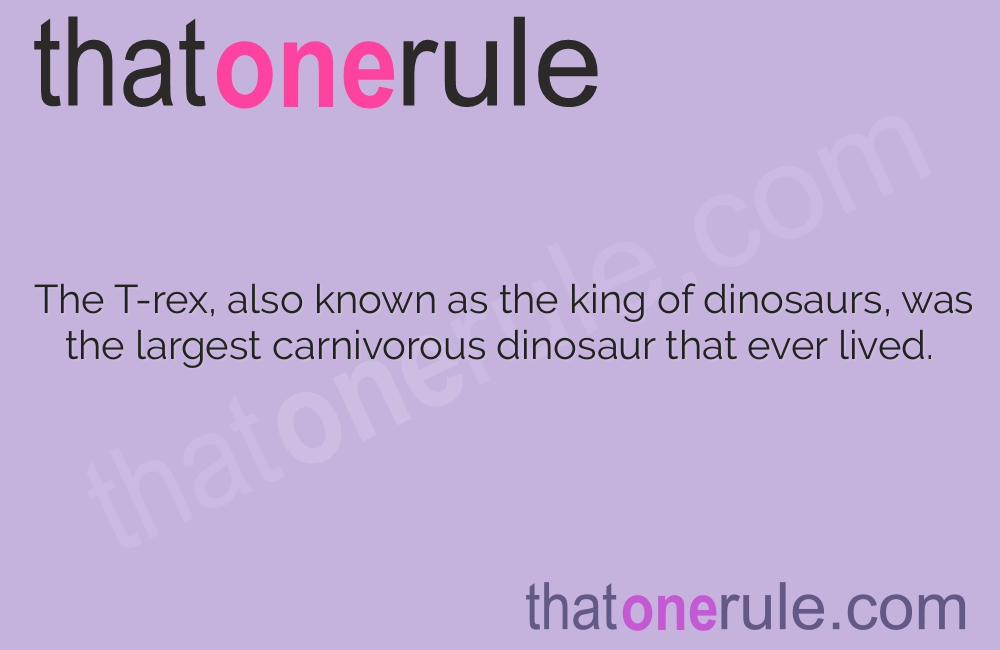T Rex – Facts and Information

The T-rex, also known as the king of dinosaurs, was the largest carnivorous dinosaur that ever lived.
T-rex belongs to the theropod group, which means beast-footed dinosaurs.
T-rex walked on two legs, and its powerful hind legs helped it run at speeds of up to 20 miles per hour.
With its massive skull and sharp teeth, the T-rex had one of the most powerful bites of any animal that ever existed.
The T-rex had tiny arms in proportion to its body size, which some scientists still debate the function of.
Despite its small arms, the T-rex had strong and muscular legs that allowed it to tackle its prey.
T-rex had a keen sense of smell, which helped it locate food from long distances.
The T-rex had excellent vision with forward-facing eyes, giving it depth perception and the ability to focus on its prey.
T-rex had a massive tail that helped it maintain balance while running and maneuvering.
The T-rex’s massive jaws contained around 50 to 60 large, sharp teeth.
The bite force of a T-rex was estimated to be around 12,800 pounds, making it one of the strongest of all terrestrial animals.
The T-rex’s name, meaning tyrant lizard king, perfectly describes its intimidating presence.
T-rex existed during the Late Cretaceous Period, around 68 to 66 million years ago.
The exact lifespan of a T-rex is still uncertain, but it is believed to have lived for approximately 20 to 30 years.
T Rex – Facts and Information part 2
T-rex had a long neck, allowing it to reach and tear flesh from its prey easily.
Unlike many other dinosaurs, the T-rex did not have feathers; instead, it had scaly and possibly leathery skin.
T-rex had well-developed olfactory bulbs in its brain, indicating a keen sense of smell.
The T-rex likely had a relatively high body temperature, allowing it to be an active predator.
Recent studies suggest that the T-rex may have been covered in a thin layer of feathers, similar to modern-day birds.
The T-rex is believed to have been an opportunistic scavenger as well as a fierce predator.
T-rex had the ability to crush bones with its strong jaw muscles, ensuring no part of its prey was wasted.
The T-rex’s teeth were constantly replaced throughout its life, similar to sharks.
Some paleontologists propose that the T-rex had feathers on its head, forming a crest or mane.
The T-rex had sharp claws, especially on its hind feet, which were used to immobilize and tear apart its prey.
Some researchers suggest that the T-rex may have been capable of hunting in packs or family groups.
The T-rex’s brain was relatively large and complex compared to other dinosaurs of its time.
T-rex was a unique and iconic dinosaur, representing the epitome of power and strength.
The T-rex’s distinctive roar, as portrayed in movies, is purely speculative since scientists have no definitive way of knowing how it sounded.
The size and power of the T-rex may have been instrumental in shaping the ecosystem of its time.
T-rex would swallow its food in large chunks, using its teeth primarily for cutting and tearing.
The T-rex is estimated to have weighed between 5 and 7 tons, making it one of the heaviest land-based carnivores.
The T-rex’s teeth were sharp banana-shaped as juveniles and became more stout and rounded as they matured.
An adult T-rex could surpass 40 feet in length and stand over 13 feet tall at the hips.
Fossil evidence suggests that the T-rex had a keen sense of hearing, which aided in detecting potential prey or dangers.
While the T-rex is often portrayed as a solitary creature, there is evidence to suggest that they were at least aware of others of their species.
The name T-rex was coined by the paleontologist Henry Fairfield Osborn in 1905 after discovering the first relatively complete skeleton.
The first T-rex fossil was discovered in the Hell Creek Formation in Montana, United States.
The T-rex had a row of serrated teeth, which could inflict massive damage on its victims.
T-rex had a unique feature called a nasal passage that likely helped it vocalize or regulate temperature.
Paleontologists believe that T-rex was an apex predator, meaning it was at the top of the food chain in its ecosystem.
Despite its ferocity, T-rex faced threats from other large predators of its time, such as the Spinosaurus.
Scientists estimate that a mature T-rex needed to consume around 40 to 60 pounds of meat daily to survive.
The arms of a T-rex were relatively weak in comparison to its large body, leading to various speculations about their functions.
Some researchers suggest that the T-rex may have used its arms to help it get up from a lying position or for balance while mating.
The T-rex’s fossils continue to captivate scientists and the general public, providing valuable insights into the prehistoric world they once ruled.

